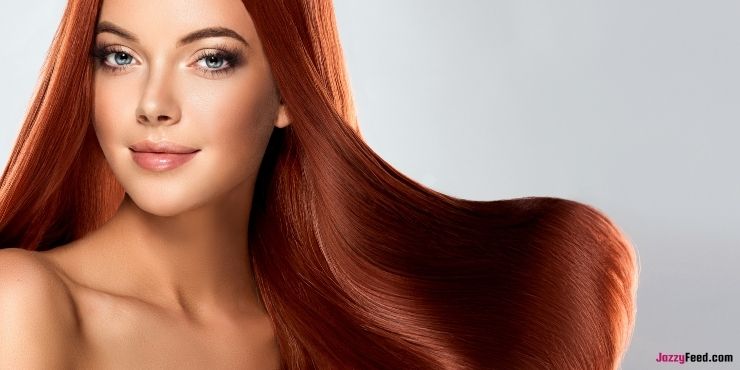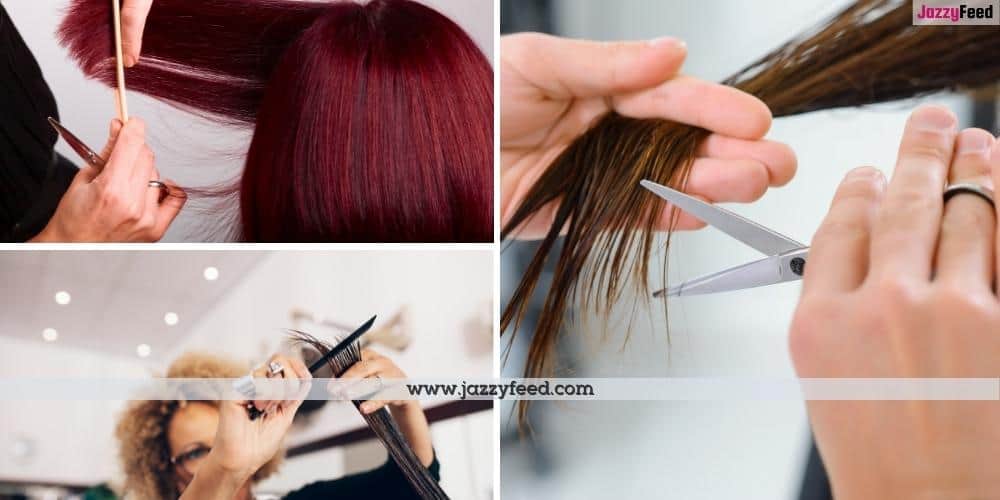When it used to look luscious and bouncy, does your hair now look dull and lifeless? Is moisture slowly evaporating from your hair? There’s a good chance you’re getting split ends. In addition to robbing your hair of its shine, split ends also inhibit hair growth. Let’s find out what causes split ends before we discuss the importance of trimming them. Check out these tips!
What Causes Split Ends?
Rather than reaching for the cause, let’s first ask what split ends are – and specifically, what causes them? Split ends occur when the outer protective layer of your hair (the hair cuticle) gets damaged and begins to wear off. As a result, the delicate inner layer of your hair becomes exposed and weakened, causing split ends.

Split ends can be caused by a wide variety of factors. As much as we may be able to blame some of this on the harsh environment we subject our hair to every time we step outside, we also need to examine our own treatment of (or mistreatment of) our hair. Here are a few of the most common causes of split ends.
- When your hair is dry, detangle it aggressively
- Detangling wet hair
- When you step out in the sun without covering your hair, you will suffer sun damage
- Overusing heat styling tools such as straightening irons, curling wands, and blow dryers
- Having your hair trimmed infrequently
- Keeping your hair unconditioned
- Daily hair washing
- Using chemical treatments such as hair color, relaxers, and perms
- In addition to gel, mousse, wax, hair sprays, etc., use too many styling products.
- The use of cheap quality synthetic brushes, combs, and other hair tools and products
- Using pillowcases of low quality or rough texture
- Lack of protein, vitamins, and minerals in the diet.
Start with baby steps: trim your split ends instead of wondering how to cut off split ends.
Why Do You Need to Trim Split Ends?
Leaving your split ends untreated can make your hair look dull, damaged, and lifeless, among many other problems. You should be aware of the following:
- There is no magic cure for split ends: Split ends do not magically fuse back together when you start conditioning or taking care of your hair. Each end splits more and more the longer you wait to trim it, which seriously hinders the growth of your hair.
- Split ends tend to be lighter in color than your natural hair color. A discolored and uneven hair color can result from this.
- Split ends leave your hair looking dull and lifeless and rob it of its lively glow. Split ends cannot be repaired by conditioning, hair masks, and spa treatments.

How to Trim Split Ends?
Trimming split ends is the quickest, easiest, and most convenient way to get rid of them. Now, hold on a moment! Before you head off to your hairdresser’s, hear me out. In the comfort of your own home, you can easily trim split ends! Simply grab a pair of hair-cutting scissors and you’re good to go! For curing split ends, you can choose from three different methods. Let’s go through each of them one by one.
1.Hair Twisting Method
Even professional hairdressers use this method to trim split ends! Hair twisting is a traditional way to trim split ends.
What You Need
- Hair trimming scissors
What To Do
- Dry your hair before you begin.
- Take a 1-inch section of hair and tightly twist it from roots to tips in a clockwise direction. Keeping the ends taut, twist the hair.
- Twisting the hair tightly enough will cause the split ends to stick out from the twisted section.
- Trim off these split ends that are sticking out starting at the top and working your way down.
- In the same manner, re-twist this same section in a counterclockwise direction and cut off the split ends.
2. Hair Sliding Method
Not many people know about hair sliding, which is an unconventional method. Most likely, it takes a little more effort since you have to straighten your hair before you cut off the split ends.
What You Need
- Heat protectant
- Straightening iron
- Wide toothed comb
- Hair trimming scissors
What To Do
- Straighten your hair with a heat protector. (If your hair is already straight, you can skip this step.)
- You should use a wide-toothed comb to remove knots and tangles in your hair.
- Take a 1-inch section of hair.
- Take this strand of hair and weave it under your index finger, over your middle finger, and under your ring finger starting at the roots. As a result, only your middle finger will show your hair.
- You will be able to see the split ends sticking out above your middle finger due to the weaving action.
- With the hair trimming scissors, cut off these split ends.
- While the hair is still woven through your fingers, slide your fingers down the section of hair and trim off any split ends.
- Slide and trim the section until the end is reached. Simply repeat the same procedure on your hair all over.
3. Trimming the Ends
Alternatively, if you don’t have the time (or patience!) to follow the twisting and sliding methods, you can simply trim off the ends of your hair to remove split ends.
What You Need
- Hairbrush/wide-toothed comb
- Hair trimming scissors
What To Do
- It is best to start with damp hair. Upon stepping out of the shower, you can spray your hair with water to dampen it.
- Clear your hair of knots and tangles.
- Take a 1-inch section of hair. To keep your hair out of the way, clip it up.
- The roots of this section of hair are right between your middle and index fingers.
- Holding the hair taut between your fingers, slide your fingers down until you reach the ends.
- You can carefully cut about 1-2 inches off your hair by keeping the scissors perpendicular to the hair.
- Following the same procedure, trim the ends of all your hair.
Split ends are easy to remove, but they are an indication of poor hair health. In order to prevent split ends in the future, you should start taking better care of your hair and restoring its health.
How Often You Should Trim Your Hair?
The most difficult aspect of any hair-care routine is dealing with split ends. It makes no difference whether your hair is as straight as an arrow or curlier than a Slinky. Trimming your hair on a regular basis is essential if you want healthy hair. But what exactly does the term “regular” imply? You’ve probably heard a variety of figures thrown around. But we turned to the experts for definitive answers for each hair type.
To begin, it is critical to understand that no one is immune to split ends. Even if you strictly adhere to all of the hair-care guidelines, your ends will eventually break. Typically, wear and tear causes ends to split. Elemental exposure can also have an effect. When you combine all of this with your daily habits, the oldest parts of the hair shaft will begin to split. Hair grows half an inch per month on average on all types of hair. If you have six-inch-long hair, the ends are a year old. And if you have shoulder-length hair, it’s probably two years old. And this alone ages and dries out hair. So, how do you know when it’s time to trim your ends?
Fine Hair
If you have fine hair, a strict routine for trimming ends is essential. Split ends can make the hair appear thin and frail. When they split, they continue to unravel up the hair shaft, and if you don’t cut those ends off, it will split much more quickly. It’s also very noticeable when compared to finer textures.
Every five weeks, visit your hairdresser. This way, you’ll keep seeing growth while keeping the ends looking full and healthy. Meanwhile, keeping your hair off your neck, especially during the colder months when you’re wearing turtlenecks and scarves, is one way to protect your ends from constant wear and tear.

Wavy Hair
Do you have a few bends in your hair but not enough to wake up with bouncy curls? If you avoid heat damage, you can go up to six weeks without a trim. You might be tempted to use a flatiron on your waves every day, but the constant heat will dry out the ends. One thing I strongly believe in is sleeping with silk rollers. It reduces the friction that dry materials can cause. That way, you’re protecting the ends while getting some beauty rest, and you’re reducing the heat.

Curly Hair
If your ringlets seem to tangle faster than your iPhone headphones, it’s time to get the scissors out. When ends split, they tend to knot together. Before styling your hair, use a good detangler to help you work through knots. However, combing through split ends on a regular basis can cause even more damage. Uncontrollable frizz is another sign that your hair needs to be trimmed. Some curly girls can go up to eight weeks without getting their hair cut. Just pay attention to your hair. It will notify you when the time has come.

coily hair
Oils must travel further to reach the ends of curly and coily hair. And split ends are the same as dry ends. That is why retaining moisture is essential. Co-washing your hair will help to keep it moisturised. Include protective styles in your routine (think braids and buns) and practise low manipulation (keeping combing, brushing, and styling to a minimum). You’ll also be able to extend trims for 8 to 12 weeks. Think of your hair as fibre or a cashmere sweater. You wouldn’t drag your hands over a delicate cardigan 100 times, so be gentle with your hair when combing and styling it.

color-treated hair
Chemically treated hair is more prone to breakage than natural hair. Then, when you combine highlights with straightening procedures, you get a double whammy. When it comes to processed hair, the rule of thumb is to get a trim with each treatment. Make sure you don’t skip your trim if you get your roots touched up every four weeks. Even if you can’t see any physical damage on your ends, it’s critical to trim them as soon as possible. It should be cut before it splits. It rides up the hair shaft once it splits. And you end up with two fine wispy pieces that break off eventually. When you combine regular trims with a bi-weekly hair mask, you’ll be on your way to shiny, healthy hair.

What Are the Ways To Prevent Split Ends?
Split ends can have a negative impact on the health and appearance of your hair. But, fortunately for you, there are a plethora of things you can do to avoid them from forming in the first place. Here are a few pointers and tricks to get you started.
Trim your hair regularly
Every time you wash and comb your hair, it suffers some wear and tear, which leads to split ends. So, how frequently should you cut your hair? It is recommended that you have your hair trimmed every 2-3 months.
Oil your hair before you wash it
We’ve all heard that oiling your hair can nourish and moisturize it from the inside out. However, it also helps your hair by forming a protective sheath around it, which reduces the damage caused by washing and shampooing.
Reduce use of heat styling tools
Using heat styling tools like blow dryers, flat irons, and curling wands on a regular basis depletes your hair’s moisture, leaving it dry, brittle, and prone to split ends. So, try to avoid using them as much as possible, and when you do, make sure to apply a heat protectant to your hair first.
Don’t wash your hair every day and avoid using hot water
Doing either or both of these things can dehydrate and weaken your hair by stripping it of its natural oils.
Dry your hair gently
Rubbing your wet hair vigorously with a towel can cause severe damage and split ends. Instead, wrap your hair in a microfiber towel until all of the excess water has been absorbed, then let it air dry the rest of the way.
Apply a leave-in conditioner
Leave-in conditioners make your hair more manageable and easier to detangle, lowering the likelihood of split ends. So, after you get out of the shower, apply a leave-in conditioner (or a small amount of natural oil).
Use a wide-toothed comb
To prevent further knotting, breakage, and split ends, use a wide-toothed comb and work your way up from the ends towards your scalp.
Wear a hat/scarf while stepping out
Allowing your hair to be exposed to the hot sun or cold winds can cause it to become brittle and prone to split ends. So, wear a hat or wrap a scarf around your head to protect your hair while making a fashionable statement.
Deep condition regularly
Deep conditioning your hair every two weeks is essential for restoring moisture and nourishing it from within.
Use products that contain PEC
PEC, or Polyelectrolyte Complex, is a new component that has been discovered to repair split ends by penetrating and sealing the hair shaft from within. So, if you want to fix split ends as well as prevent them from forming, choose a conditioner that contains PEC.
Use soft hair ties
Rubber hair ties or those with a metal clasp in the middle tend to break your hair and cause split ends. As a result, use hair ties that are gentle on your hair.
Oil your hair before swimming
Swimming in harsh chlorine-infused water on a regular basis can cause irreversible damage to your hair. So, before you dive into the pool, apply a protective layer of coconut oil to your hair and put on a swim cap.
Eat a balanced diet and drink lots of water
Eating a well-balanced diet rich in proteins, vitamins, and minerals, as well as staying hydrated, is critical for maintaining the health of your hair.
FAQs – Hair Trimming Splits
What happens if you don’t trim split ends?
Split ends damage more than just the ends, resulting in breakage, frizz, and scraggly strands that refuse to blend with the rest of your hair. Split ends are not only unsightly, but they also aggravate the condition of your hair.
Does a trim help split ends?
FALSE, hair trimming has no direct effect on hair growth. Trimming the hair and splitting the ends does not cause the hair to grow. What it does is promote growth because once a hair has a split end, it will continue to split, resulting in breakage or what appears to be no growth.
Why you should never cut your hair?
Your hair ceases to grow. By not cutting your hair, you are actually putting the length at risk rather than letting it grow. When those split ends travel up your hair and break it off higher, leaving your hair shorter than before—as was the case with sad locks.
Do I really need to trim my hair?
If your hair is prone to split ends or you use a lot of chemical treatments, trimming it every eight weeks will help keep it healthy. On the other hand, there’s no reason why you can’t have long, healthy hair—and regular trims can definitely help you get there.
Why did my hair stop growing after I cut it?
Hair growth and health are sometimes solely determined by genetics. Hair stops growing after a certain period of time, not when it reaches a certain length. As a result, once the hair reaches the end of its growth cycle, it will stop growing and will either break off, shed, or be cut off at the hairdresser.
Does your hair grow faster if you trim it?
Myth: Trimming the ends of your hair on a regular basis does not stimulate hair growth. And the answer is, of course, no! Cutting the ends of your hair on a regular basis will not make it grow faster. It does, however, make your hair appear thicker, healthier, and shinier.

